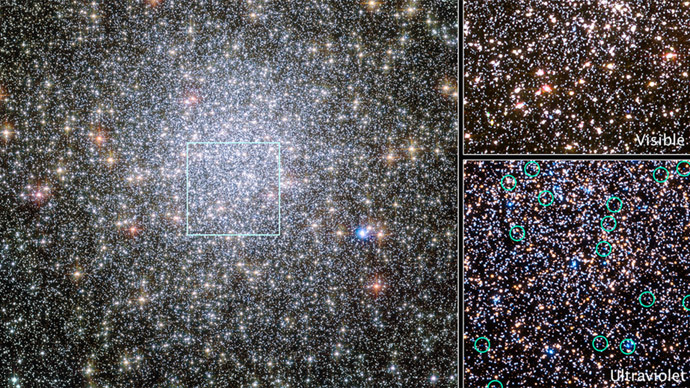For the first time ever NASA astronomers have captured snapshots of white dwarf stars embarking on their 40-million-year epic migration from the "star-studded" center of an ancient star cluster to less populated environs.
These white dwarfs (also called degenerate dwarfs) are the burned-out relics of stars that rapidly lose mass, cool down and shut off their nuclear furnaces. Their luminosity arises from the emission of stored thermal energy. A white dwarf's mass is comparable to the Sun’s, and its volume to that of the Earth.
Their migration is caused by a gravitational tussle among stars inside the cluster, NASA explains. Mass is a deciding factor in globular star clusters: heavier stars slow down and sink to the cluster's core, while lighter stars gain momentum and move across the cluster to the edge. Astronomers call the process "mass segregation."
In their study, which involved about a quarter of all the white dwarfs in the cluster, the astronomers managed to catch the stars in the process of moving outward and segregating themselves according to mass.
#Hubble spies parade of white dwarfs migrating away from core of globular cluster 47 Tucanae. http://t.co/jTgEUCmcxKpic.twitter.com/USvJSFaXmm
— HubbleTelescope (@HubbleTelescope) May 14, 2015
"The entire process doesn’t take very long, only a few hundreds of millions of years, out of the 10-billion-year age of the cluster, for the white dwarfs to reach their new home in the outer suburbs,” Jeremy Heyl of the University of British Columbia (UBC), lead author on the science paper published in the Astrophysical Journal, was quoted as saying by NASA.
NASA used Hubble to watch the white-dwarf exodus in the globular star cluster 47 Tucana, a dense swarm of hundreds of thousands of stars in the Milky Way. It's about 16,700 light years away from Earth and 120 light years across. Located in the Tucana constellation, it can actually be seen with the naked eye.
Thanks to the ultraviolet-light capabilities of Hubble’s Wide Field Camera 3, hailed as the most technologically advanced instrument to take images in the visible spectrum, the astronomers examined some 3,000 white dwarfs, tracing two populations with diverse ages and orbits.

One grouping appeared to be 6 million years old and had just embarked on their journey; another was around 100 million years old and had already arrived at its new location, roughly 1.5 light-years (nearly 9 trillion miles) away from the center.
The astronomers estimated the white dwarfs’ ages by scrutinizing their colors, which gives them the stars’ temperatures. The hottest dwarfs shine vividly in ultraviolet light. Only Hubble can detect these stars because ultraviolet light is blocked by Earth’s atmosphere and cannot reach ground-based telescopes, according to NASA.
The migrating white dwarfs are not in a rush to depart: their orbits expand outward as slowly as an average car, at about 30 miles an hour (about 50km/h). The dead stars continue to move at this pace for about 40 million years, until they reach a location that better fits their mass. The astronomers were at a loss when they found that the youngest white dwarfs were just embarking on their journey, NASA reported. This discovery could serve as evidence that the stars shed much of their mass later in their lifecycles than previously thought.
READ MORE: White dwarf has Napoleon Complex, destroys passing planet
About 100 million years before stars evolve into white dwarfs, they swell up and turn into red giants. Astronomers previously assumed that stars lose most of their mass during this phase by blowing it off into space. The latest Hubble observations reveal, however, that the stars only dump between 40 to 50 percent of their bulk about 10 million years before completely burning out as white dwarfs.
“This late start is evidence that these white dwarfs are losing a large amount of mass just before they become white dwarfs and not during the earlier red giant phase, as most astronomers had thought,” Richer said.
“That’s why we are seeing stars still in the process of moving slowly away from the center of the cluster. It’s only after they lose their mass that they get gravitationally pushed out of the core. If the stars had shed most of their weight earlier in their lives, we wouldn’t see such a dramatic effect between the youngest white dwarfs and the older ones that are 100 million years old," he explained.

